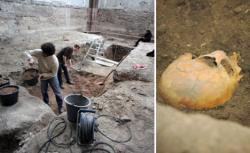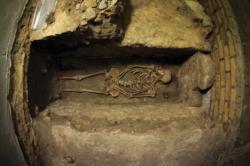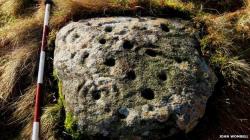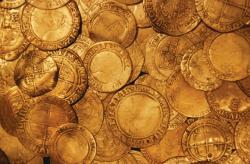INSTITUT SUPERIEUR D'ANTHROPOLOGIE
INSTITUTE OF ANTHROPOLOGY
ONLINE COURSES / COURS A DISTANCE
SPRING TERM : APRIL 2014
REGISTER NOW
ITALIE –  Arezzo -An important archeological find of ancient Roman ruins has been made at the Medici Fortress of Arezzo in central Italy. During work for the reorganization of the historic building, evidence of an ancient Roman structure dating from the early decades of the first century AD were brought to light - probably a residence, or domus. The ancient ruins are believed to be a residential building from the Roman period in which three rooms so far have been identified. Remains of painted wall and floors have been found in two partially investigate rooms. The building, located in the northeastern plateau of the San Donato hill, was perched above the hillside's the steep slopes overlooking the valley below.The floors found are attributable to the Augustan-Julio Claudian era (from late BC to the first decades AD), and show striking similarities to mosaics of the Villa dell'Ossaia in Cortona.During the excavations, the burial remains of a warrior came to light - perhaps a medieval knight. The burial - still only partially seen by the experts conducting the excavations - is of a man with a long iron sword. According to preliminary investigations, the burial dates from around the year 1000.Above a layer of collapsed floors of the Roman 'domus' there are signs of reuse later abandoned, including of course, the burial of the ''knight''.
Arezzo -An important archeological find of ancient Roman ruins has been made at the Medici Fortress of Arezzo in central Italy. During work for the reorganization of the historic building, evidence of an ancient Roman structure dating from the early decades of the first century AD were brought to light - probably a residence, or domus. The ancient ruins are believed to be a residential building from the Roman period in which three rooms so far have been identified. Remains of painted wall and floors have been found in two partially investigate rooms. The building, located in the northeastern plateau of the San Donato hill, was perched above the hillside's the steep slopes overlooking the valley below.The floors found are attributable to the Augustan-Julio Claudian era (from late BC to the first decades AD), and show striking similarities to mosaics of the Villa dell'Ossaia in Cortona.During the excavations, the burial remains of a warrior came to light - perhaps a medieval knight. The burial - still only partially seen by the experts conducting the excavations - is of a man with a long iron sword. According to preliminary investigations, the burial dates from around the year 1000.Above a layer of collapsed floors of the Roman 'domus' there are signs of reuse later abandoned, including of course, the burial of the ''knight''.
http://www.ansamed.info/ansamed/en/news/sections/culture/2014/02/27/Archaeology-ancient-Roman-house-found-Arezzo_10151925.html
ALLEMAGNE – 
 Mainz - In Mainz Cathedral, which is today the evangelical Church of St John, archaeologists found the remains of another church built 1,200 years ago in the time of Charlemagne, Deacon Andreas Klodt said on Tuesday. Only Trier on the Mosel River has an older church, with its cathedral dating back to Roman times. This makes Mainz Cathedral 200 years older than initially believed and the second oldest in the country. Professor Matthias Untermann from the Institute of Art History in Heidelberg said the remains of the Carolingian walls stretched from the basement to the roof.The Rhineland-Palatinate state curator Joachim Glatz said: "This is the only surviving Carolingian cathedral in Germany." Usually a bishop would build a cathedral in the Middle Ages at the exact location of the previous building, getting rid of the older church. But in Mainz the 1,000-year-old cathedral was incorporated into the Carolingian one.Archaeologist Ronald Knöchlein said Mainz had a Christian community in Roman times. And according to Knöchlein two human skeletons have been found during the excavations so far - remains of earlier burials in the church. The cathedral has been used since the 19th Century by the evangelical community. During the Second World War, it was destroyed by fire after a bomb attack. Demolition was considered but rejected. The dig is continuing.
Mainz - In Mainz Cathedral, which is today the evangelical Church of St John, archaeologists found the remains of another church built 1,200 years ago in the time of Charlemagne, Deacon Andreas Klodt said on Tuesday. Only Trier on the Mosel River has an older church, with its cathedral dating back to Roman times. This makes Mainz Cathedral 200 years older than initially believed and the second oldest in the country. Professor Matthias Untermann from the Institute of Art History in Heidelberg said the remains of the Carolingian walls stretched from the basement to the roof.The Rhineland-Palatinate state curator Joachim Glatz said: "This is the only surviving Carolingian cathedral in Germany." Usually a bishop would build a cathedral in the Middle Ages at the exact location of the previous building, getting rid of the older church. But in Mainz the 1,000-year-old cathedral was incorporated into the Carolingian one.Archaeologist Ronald Knöchlein said Mainz had a Christian community in Roman times. And according to Knöchlein two human skeletons have been found during the excavations so far - remains of earlier burials in the church. The cathedral has been used since the 19th Century by the evangelical community. During the Second World War, it was destroyed by fire after a bomb attack. Demolition was considered but rejected. The dig is continuing.
http://www.thelocal.de/20140227/germanys-second-oldest-church-hidden-for-1200-years-found-in-mainz-cathedral?
ROYAUME UNI – 
 Ross-shire - A rare example of prehistoric rock art has been uncovered in the Highlands. Archaeologists made the discovery while moving a boulder decorated with ancient cup and ring marks to a new location in Ross-shire. When they turned the stone over they found the same impressions on the other side of the rock. It is one of only a few decorated stones of its kind.Susan Kruse, of Archaeology for Communities in the Highlands (ARCH), first discovered the stone at Heights of Fodderty several years ago when out walking. The second set of cup and ring marks were uncovered recently when archaeologists were moving the stone to a new site at nearby Heights of Brae Neil Gunn Viewpoint. From the Neolithic or Bronze Age, the art was created between 4,000 and 5,000 years ago.Archaeologists believe the markings may have been made for a number of reasons. These include for rituals, as territorial markers or mapping the stars. They could even be the "doodlings" of bored, ancient shepherds. Ms Kruse said: "Finding cup and ring decoration on the opposite side has raised a number of tantalising questions. "Was the decoration meant to be viewed from both sides or was one decorated side deliberately placed face down? "Or was the stone carved at different times?"There is a cluster of rock art in the local area. A Neolithic chambered burial cairn and round houses dating to the Bronze and Iron Ages have also been found. Another major discovery in the area was the Heights of Brae hoard, the largest surviving late Bronze Age gold find in Scotland. A farmer uncovered the jewellery while ploughing a field in the 1960s.
Ross-shire - A rare example of prehistoric rock art has been uncovered in the Highlands. Archaeologists made the discovery while moving a boulder decorated with ancient cup and ring marks to a new location in Ross-shire. When they turned the stone over they found the same impressions on the other side of the rock. It is one of only a few decorated stones of its kind.Susan Kruse, of Archaeology for Communities in the Highlands (ARCH), first discovered the stone at Heights of Fodderty several years ago when out walking. The second set of cup and ring marks were uncovered recently when archaeologists were moving the stone to a new site at nearby Heights of Brae Neil Gunn Viewpoint. From the Neolithic or Bronze Age, the art was created between 4,000 and 5,000 years ago.Archaeologists believe the markings may have been made for a number of reasons. These include for rituals, as territorial markers or mapping the stars. They could even be the "doodlings" of bored, ancient shepherds. Ms Kruse said: "Finding cup and ring decoration on the opposite side has raised a number of tantalising questions. "Was the decoration meant to be viewed from both sides or was one decorated side deliberately placed face down? "Or was the stone carved at different times?"There is a cluster of rock art in the local area. A Neolithic chambered burial cairn and round houses dating to the Bronze and Iron Ages have also been found. Another major discovery in the area was the Heights of Brae hoard, the largest surviving late Bronze Age gold find in Scotland. A farmer uncovered the jewellery while ploughing a field in the 1960s.
http://www.bbc.com/news/uk-scotland-highlands-islands-26366644
USA – 
 Spiro Mounds - For the first time since 1982, major excavations at the Spiro Mounds Archaeological Center in eastern Oklahoma will begin May 19 and continue each weekday through June 20. “The focus of the work will be several remote sensing anomalies that may be possible structures,” Blackburn said. “One of the anomalies was revealed during the short excavation in October 2013, and researchers uncovered the first round structure ever seen at the site. The 2014 work will be focused on three other anomalies, which are being eroded by a stream in the area of the October dig. “The Spiro Mounds culture goes back to about A.D. 850 near what is now the town of Spiro. In 2012 and 2013, Phase One of a remote sensing survey was conducted by researchers from the Oklahoma Archeological Survey and the Arkansas Archeological Survey in association with researchers from OU, the University of Arkansas-Fayetteville and the University of Arkansas-Fort Smith. Remote sensing, Peterson said, uses various technologies, such as ground penetrating radar, gradiometer and magnetometers, that allow for patterns beneath the soil to be seen before any digging. “Preliminary data shows at least 50 possible house patterns,” Peterson said, “and a lot of patterns that archaeologists are not sure what they are yet. There are several of these house patterns that are being impacted by a drainage ditch. The excavations during October were focusing on one of those possible house patterns. “The October excavations included very few artifacts and almost nothing that tells researchers about the time of use. It is hoped that more artifacts will be found in the 2014 research, and a better understanding of the structures will be gleaned.”
Spiro Mounds - For the first time since 1982, major excavations at the Spiro Mounds Archaeological Center in eastern Oklahoma will begin May 19 and continue each weekday through June 20. “The focus of the work will be several remote sensing anomalies that may be possible structures,” Blackburn said. “One of the anomalies was revealed during the short excavation in October 2013, and researchers uncovered the first round structure ever seen at the site. The 2014 work will be focused on three other anomalies, which are being eroded by a stream in the area of the October dig. “The Spiro Mounds culture goes back to about A.D. 850 near what is now the town of Spiro. In 2012 and 2013, Phase One of a remote sensing survey was conducted by researchers from the Oklahoma Archeological Survey and the Arkansas Archeological Survey in association with researchers from OU, the University of Arkansas-Fayetteville and the University of Arkansas-Fort Smith. Remote sensing, Peterson said, uses various technologies, such as ground penetrating radar, gradiometer and magnetometers, that allow for patterns beneath the soil to be seen before any digging. “Preliminary data shows at least 50 possible house patterns,” Peterson said, “and a lot of patterns that archaeologists are not sure what they are yet. There are several of these house patterns that are being impacted by a drainage ditch. The excavations during October were focusing on one of those possible house patterns. “The October excavations included very few artifacts and almost nothing that tells researchers about the time of use. It is hoped that more artifacts will be found in the 2014 research, and a better understanding of the structures will be gleaned.”
http://newsok.com/spiro-mounds-excavations-visits-to-resume-in-eastern-oklahoma/article/3936596
USA –  Saddle Ridge-A California couple out walking their dog struck it rich by unearthing a horde of buried gold coins, worth more than $10 million according to experts.The couple found 1,400 gold coins in an area known for buried treasure since the Gold Rush in the 19th century. The so-called Saddle Ridge find is believed to be the most valuable treasure trove ever discovered in the United States, according to Kagin's Inc, which specializes in ancient gold coins.
Saddle Ridge-A California couple out walking their dog struck it rich by unearthing a horde of buried gold coins, worth more than $10 million according to experts.The couple found 1,400 gold coins in an area known for buried treasure since the Gold Rush in the 19th century. The so-called Saddle Ridge find is believed to be the most valuable treasure trove ever discovered in the United States, according to Kagin's Inc, which specializes in ancient gold coins.
http://news.discovery.com/human/life/calif-couple-strike-gold-with-buried-treasure-140226.htm
BULGARIE –  Pautalia- Bulgaria's government has set aside BGN 5 M for the restoration of the Pautalia acropolis, near Kyustendil. The project includes the restoration of the medieval fortress on the Hisarluka hill and the setting up of a museum with artifacts from the area. Additional archaeological excavations will expose the early Christian basilica, which had been built on the site of an ancient temple of Apollo. According to Kyustendil's mayor Petar Paunov, the project could be completed by the end of this year. The Thracian town of Pautalia was founded in 5th-4th centuries BC near the hot springs in the area. Later the Romans developed it into a stronghold, balneological center and trading post. In the Middle Ages the town was called Velbazhd and had been part of the Byzantine Empire and the Second Bulgarian Kingdom.
Pautalia- Bulgaria's government has set aside BGN 5 M for the restoration of the Pautalia acropolis, near Kyustendil. The project includes the restoration of the medieval fortress on the Hisarluka hill and the setting up of a museum with artifacts from the area. Additional archaeological excavations will expose the early Christian basilica, which had been built on the site of an ancient temple of Apollo. According to Kyustendil's mayor Petar Paunov, the project could be completed by the end of this year. The Thracian town of Pautalia was founded in 5th-4th centuries BC near the hot springs in the area. Later the Romans developed it into a stronghold, balneological center and trading post. In the Middle Ages the town was called Velbazhd and had been part of the Byzantine Empire and the Second Bulgarian Kingdom.
http://www.novinite.com/articles/158544/Ancient+Acropolis+To+Be+Restored+in+Bulgaria%27s+Kyustendil
MYANMAR –  Mandalay - The tomb of Thai King Uthumphon in the ancient capital of Amarapura in Mandalay is under threat because of plans to build a park in the vicinity. Last year, archaeologists discovered the remains of a monastery underneath the foundation of the tomb.
Mandalay - The tomb of Thai King Uthumphon in the ancient capital of Amarapura in Mandalay is under threat because of plans to build a park in the vicinity. Last year, archaeologists discovered the remains of a monastery underneath the foundation of the tomb.
http://www.southeastasianarchaeology.com/